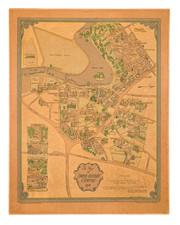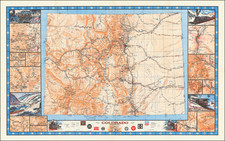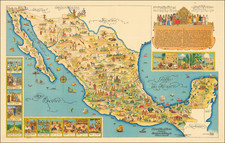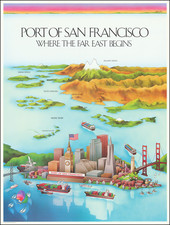Provocative anti-fascist satirical map, drawn by Richard Q. Yardley and Peggy Yardley, one of a series of anti-fascist maps drawn by Yardley for Ken Magazine and one of the few Yardley works which include a credit to his wife Peggy.
The map illustrates in graphic and sometimes ethnically inappropriate images, the former African colonies then in controversy.
In addition to the anti-Hitler message, the image also takes aim at Fascist Italy, then led by Mussolini, and its colonial interests in Ethiopia and the contiguous regions of the Arabian Peninsula.
Images of cowering and ineffective Britain (in South Africa) and France (in Algeria), punctuate the Yardley's powerful message.
As noted on the website for the PJ Mode Collection of Persuasive Cartography at Cornell University describing one of Yardley's other anti-Fascist maps:
This 1938 satirical map Ken Magazine attacks Hitler and the growing threat of Nazi Germany. Cartoon figures throughout the country show a few humorous developments ("factory devoted exclusively to making medals for Goering") and many that ominously foreshadow what was to come, including propaganda, "big book burning festival," "happy labor - no strikes," "to the Ukraine," and "concentration camps."
Ken was a controversial anti-fascist magazine, first published in April 1938. It was distinguished by unusual and powerful graphics like this one and a number of articles on the Spanish Civil War by Ernest Hemingway. The magazine failed in August 1939 as a result of wariness by advertisers and a boycott by the Catholic Church. Baptista 2009, 109-115.
Richard Q. Yardley
Richard Quincy Yardley (1903-1979) was an American editorial cartoonist.
Born in Baltimore, Maryland on March 11, 1903, Yardley attended the Friends School and the Maryland Institute. Yardley started as an artist-retoucher in the news department at the Baltimore Evening Sun in 1923 and moved into creating local news and commentary cartoons in 1934, for the Morning Sun.
In 1949, he became the Sun's editorial cartoonist after Edmund Duffy's retirement. From 1961 until 1965, Yardley also drew the daily comic strip panel, Our Ancestors, which was syndicated by the Newspaper Enterprise Association. In addition to these works, his cartoons appeared in the New Yorker and the Reporter. Yardley was a member of the National Cartoonists Society, the American Association of Editorial Cartoonists and the National Press Club.
Richard Q. Yardley (1903-1979) was an American editorial cartoonist.
Born in Baltimore, Maryland on March 11, 1903, Yardley attended the Friends School and the Maryland Institute. Yardley started as an artist-retoucher in the news department at the Baltimore Evening Sun in 1923 and moved into creating local news and commentary cartoons in 1934 for the Morning Sun.
In the late 1930s, Yardley drew several provacative pictorial maps for the anti-Fascist Ken Magazine.
In 1949 he became the Sun’s editorial cartoonist after Edmund Duffy’s retirement.
From 1961 until 1965 Yardley also drew the daily comic strip panel, Our Ancestors which was syndicated by the Newspaper Enterprise Association. In addition to these works, his cartoons appeared in the New Yorker and theReporter. Yardley was a member of the National Cartoonists Society, the American Association of Editorial Cartoonists and the National Press Club.
Richard Q. Yardley retired in 1972 and died on November 25, 1979.
The Richard Q. Yardley Cartoons collection at Syracuse University consists of 43 original political cartoons and 2 copies of cartoons. Twelve cartoons are dated and 31 cartoons are undated. One of the cartoons is signed, "W. Hogarth Yardley" and it is unknown if this cartoon was drawn by Richard Q. Yardley. Satire and sarcasm were regularly used elements in Yardley’s cartoons.
The cartoons were drawn with ink on illustration board as well as paper with traces of blue pencil visible. The cartoons vary in size.









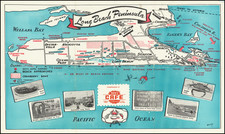
![[ Downtown St. Helena ] Mattioli's in your Pocket Guide St. Helena -- 13th Annual Edition [ Napa Valley, CA ]](https://storage.googleapis.com/raremaps/img/small/102768.jpg)
